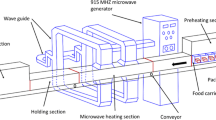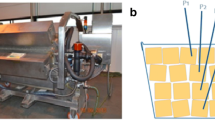Abstract
Thermal process optimization has focused on traditional sterilization, with limited research on pasteurization or microwave-assisted thermal processing. Model foods have been developed as quality evaluation tools for thermal pasteurization processes, but there are no comprehensive studies demonstrating how these model foods could be used to evaluate and compare the resulting food quality after different pasteurization processes. The aim of this study was to develop a methodology using image and quantitative analyses for quality evaluation of pre-packaged food pasteurized using a microwave-assisted pasteurization system (MAPS) and traditional hot water method. Four pasteurization processes (MAPS and hot water method at 90 and 95 °C) were designed to have an equivalent accumulated thermal lethality at the cold spot of at least 90 °C for 10 min to control nonproteolytic Clostridium botulinum spores. Color-based time-temperature indicators in mashed potato and green pea model foods were quantified using image analysis. Results showed that median color values were useful in assessing overall color change, and interquartile range was an indicator of burnt areas. MAPS 95 °C was the best process because it had the smallest hot spot cook values and the least color change, while the 90 °C hot water process was the worst. Model foods and image analysis techniques were useful pasteurization process quality evaluation tools and made it possible to visualize the potential food quality change volumetrically, throughout a food package. In the future, these tools could be combined with computer simulations to optimize the quality of pilot-scale and industrial MAPS or conventional pasteurization processes.





Similar content being viewed by others
References
Avila, I., Smout, C., Silva, C. L. M., & Hendrickx, M. (1999). Development of a novel methodology to validate optimal sterilization conditions for maximizing the texture quality of white beans in glass jars. Biotechnology Progress, 15(3), 565–572.
Benlloch-Tinoco, M., Igual, M., Salvador, A., Rodrigo, D., & Martínez-Navarrete, N. (2014). Quality and acceptability of microwave and conventionally pasteurised kiwifruit puree. Food and Bioprocess Technology, 7(11), 3282–3292.
Bornhorst, E. R., Tang, J., Sablani, S. S., & Barbosa-Cánovas, G. V. (2017a). Development of model food systems for thermal pasteurization applications based on Maillard reaction products. LWT-Food Science and Technology, 75, 417–424.
Bornhorst, E. R., Tang, J., Sablani, S. S., & Barbosa-Cánovas, G. V. (2017b). Thermal pasteurization process evaluation using mashed potato model food with Maillard reaction products. Under review: LWT-Food Science and Technology.
Bornhorst, E. R., Tang, J., Sablani, S. S., Barbosa-Cánovas, G. V., & Liu, F. (2017c). Green pea and garlic puree model food development for thermal pasteurization process quality evaluation. Under review: Journal of Food Science.
Chakraborty, S., Rao, P. S., & Mishra, H. N. (2015). Response surface optimization of process parameters and fuzzy analysis of sensory data of high pressure-temperature treated pineapple puree. Journal of Food Science, 80(8), E1763–E1775.
Chandrasekaran, S., Ramanathan, S., & Basak, T. (2013). Microwave food processing—a review. Food Research International, 52(1), 243–261.
Cha-um, W., Rattanadecho, P., & Pakdee, W. (2011). Experimental and numerical analysis of microwave heating of water and oil using a rectangular wave guide: influence of sample sizes, positions, and microwave power. Food and Bioprocess Technology, 4(4), 544–558.
Chen, H., Tang, J., & Liu, F. (2008). Simulation model for moving food packages in microwave heating processes using conformal FDTD method. Journal of Food Engineering, 88(3), 294–305.
Commonwealth Scientific and Industrial Research Organization (CSIRO). (2010). Make it safe: A guide to food safety. Collingwood: CSIRO Publishing.
Datta, A. K. (2008). Status of physics-based models in the design of food products, processes, and equipment. Comprehensive Reviews in Food Science and Food Safety, 7(1), 121–129.
Datta, A. K., & Anantheswaran, R. C. (2001). Handbook of microwave technology for food applications (pp. 18–19). New York, NY: Marcel Dekker, Inc..
European Chilled Food Federation (ECFF). (2006). Recommendations for the production of prepackaged chilled food. 2nd ed. European Chilled Food Federation.
Food and Drug Administration (FDA). (2011). Fish and fisheries products hazards and control guidance (4nd ed.) U.S. Department of Health and Human Services.
Hildenbrand, P. (1980). An approach to solving the optimal temperature control problem for sterilization of conduction-heating foods. Journal of Food Process Engingeering, 3(3), 123–142.
Holdsworth, S. D. (1997). Thermal processing of packaged foods (ch. 4 & 7) (1st ed.). New York, NY: Blackie Academic & Professional.
Huang, I.-L., Francis, F. J., & Clydesdale, F. M. (1970a). Colorimetry of foods. 2. Color measurement of squash puree using the Kubelka-Munk concept. Journal of Food Science, 35(3), 315–317.
Huang, I.-L., Francis, F. J., & Clydesdale, F. M. (1970b). Colorimetry of foods. 3. Carrot puree. Journal of Food Science, 35(6), 771–773.
Leon, K., Mery, D., Pedreschi, F., & Leon, J. (2006). Color measurement in L*a*b* units from RGB digital images. Food Research International, 39(10), 1084–1091.
Lespinard, A. R., Arballo, J. R., Taus, F. J., & Mascheroni, R. H. (2015). Multi-objective optimization of the pasteurization process of pumpkin cubes packaged in glass jars. International Journal of Food Engineering, 11(5), 679–689.
Luan, D., Tang, J., Pedrow, P. D., Liu, F., & Tang, Z. (2013). Using mobile metallic temperature sensors in continuous microwave assisted sterilization (MATS) systems. Journal of Food Engineering, 119, 552–560.
Mahy, M., Van Eyckden, L., & Ooosterlinkc, A. (1994). Evaluation of the uniform color spaces developed after the adoption of CIELAB and CIELUV. Color Research Application, 19(2), 105–121.
Marszalek, K., Wozniak, L., Skapska, S., & Mitek, M. (2016). A comparative study of the quality of strawberry purée preserved by continuous microwave heating and convetional thermal pasteurization during long-term cold storage. Food and Bioprocess Technology, 9(7), 1100–1112.
Miri, T., Tsoukalas, A., Bakalis, S., Pistikopoulos, E. N., Rustem, B., & Fryer, P. J. (2008). Global optimization of process conditions in batch thermal sterilization of food. Journal of Food Engingeering, 87(4), 485–494.
Pathak, S. K., Liu, F., & Tang, J. (2003). Finite domain time domain (FDTD) characterization of a single model applicator. Journal of Microwave Power and Electromagnetic Energy, 38(1), 37–48.
Peck, M. W. (2006). Clostridium botulinum and the safety of minimally heated, chilled foods: An emerging issue? Journal of Applied Microbiolgy, 101(3), 556–570.
Peng, J., Tang, J., Barrett, D. M., Sablani, S. S., Anderson, N., & Powers, J. R. (2015). Thermal pasteurization of vegetables: critical factors for process design and effects on quality. Critical Reviews in Food Science and Nutrition, 00–00.
Renna, M., Pace, B., Cefola, M., Santamaria, P., Serio, F., & Gonnella, M. (2013). Comparison of two jam making methods to preserve the quality of colored carrots. LWT-Food Science and Technology, 53(2), 547–554.
Resurreccion Jr., F. P., Tang, J., Pedrow, P., Cavalieri, R., Liu, F., & Tang, Z. (2013). Development of a computer simulation model for processing food in a microwave assisted thermal sterilization (MATS) system. Journal of Food Engineering, 118(4), 406–416.
Singh, A. P., & Ramaswamy, H. S. (2015). Effect of can orientation on heat transfer coefficients associated with liquid particulate mixtures during reciprocation agitation thermal processing. Food and Bioprocess Technology, 8(7), 1405–1418.
Smout, C., Banadda, N. E., Van Loey, A. M. L., & Hendrickx, M. E. G. (2003). Nonuniformity in lethality and quality in thermal process optimization: a case study on color degradation of green peas. Journal of Food Science, 68(2), 545–550.
Tang, J. (2015). Unlocking potentials of microwaves for food safety and quality. Journal of Food Science, 80(8), E1776–E1793.
Teixeira, A. A., Dixon, J. R., Zahradnik, J. W., & Zinsmeister, G. E. (1969). Computer optimization of nutrient retention in the thermal processing of conduction-heated foods. Food Technology, 23, 845–850.
Teixeira, A. A., Stumbo, C. R., & Zahradnik, J. W. (1975). Experimental evaluation of mathematical and computer models for thermal process evaluation. Journal of Food Science, 40(4), 653–655.
Acknowledgements
This research was supported in part by the National Institute of Food and Agriculture, U.S. Department of Agriculture, under Agreement No. 2016-68003-24840 and 2011-68003-20096. Ellen Bornhorst’s Ph.D. program at Washington State University was supported by the US Department of Agriculture, National Needs Fellowship grant (2012-38420-19287).
Author information
Authors and Affiliations
Corresponding author
Rights and permissions
About this article
Cite this article
Bornhorst, E.R., Liu, F., Tang, J. et al. Food Quality Evaluation using Model Foods: a Comparison Study between Microwave-Assisted and Conventional Thermal Pasteurization Processes. Food Bioprocess Technol 10, 1248–1256 (2017). https://doi.org/10.1007/s11947-017-1900-9
Received:
Accepted:
Published:
Issue Date:
DOI: https://doi.org/10.1007/s11947-017-1900-9




